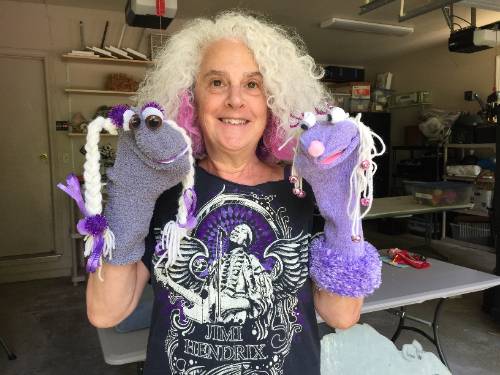Ginger Ertz
Ginger Ertz worked at Skidmore’s Tang Teaching Museum and Art Gallery for just over
15 years, retiring in January 2018. She currently serves on the board of trustees
of the MoonCatcher Project. A Skidmore College Retiree Staff grant awarded to Ginger in 2019 helped support the work of this project.
What did you do in your work at the Tang?
As the museum educator for K-12 and Community Programs, I was responsible for all
school and library programs, including Museum tours. I also traveled to schools and
libraries within a 50-mile radius of the museum, bringing programming directly to
students, K-12. I employed and mentored many Skidmore work-study students annually
— one of my many favorite parts of my job — except when they had to manage or mentor
me! I designed, or mentored others to design, the Tang’s Family Saturday programs,
about 36 joy-filled multigenerational events each year. Our programs included students
and adults with special needs (cognitive, physical, developmental and emotional, including
children with autism) adults with traumatic brain injuries and dementia. The power
of art was evident in the joy and confidence of our participants as they created their
projects.
What is The MoonCatcher Project?
The mission of the MoonCatcher Project (MCP) is to optimize girls' lives worldwide by removing barriers related to menstruation. The MoonCatcher Project makes and provides free reusable, washable menstrual pad kits (or “MoonCatcher Kits”) that can be worn with or without underwear for girls in the poorest communities worldwide. These pads provide a way for girls to stay in school while menstruating, giving them a greater chance of completing their education.

Education is the most effective means of improving the lives of girls in the world’s
poorest communities. However, girls often drop out of school when they reach puberty
because they have no access to menstrual hygiene products. This is a trend that often
leads to early marriage, childbearing at an early age and a lack of financial independence.
Here in the U.S. we hold sewing bees — MoonBees — where we make the kits as a community,
in churches, synagogues, mosques, community centers, high schools, colleges (we will
be holding our fifth annual MoonBee at the Tang on Feb. 20 ), Girl Scout troops and more. We also collect disposable menstrual supplies at every
MoonBee for girls and women in our own region who cannot afford them. We encourage
participants to donate some that we then distribute to homeless shelters, food banks
and other community service organizations. No girl here should have to miss school
because she has no way to manage her period.
What is your role in the MoonCatcher project and how did you get involved?
I became involved when my good friend Ellie von Wellsheim had the idea to create these
reusable pads, and I agreed to volunteer to be one of the people who sewed at the
MoonBees. As it grew, I became a “runner,” helping to keep all of our volunteers busy,
answering questions and training them in the various tasks. When Ellie decided to
apply for nonprofit 501c3 status, I agreed to serve on the MCP board of trustees.
As Board secretary, I have taken on the complex task of managing our schedule for
the past two years. I also talk about the need for menstrual management every chance
I get and encourage others to break the taboo we have about using words like menstruate and period. Menstrual blood is the only blood not shed through violence or injury, yet it is
the only one we dare not discuss in public.
What makes your involvement with the MoonCatcher project a satisfying occupation for your retirement?
I thrive on working with groups to make the world a little bit better than I find
it. Meeting people from all different demographic groups as we work toward a common
goal is satisfying and gratifying for me. Seeing people so ready and willing to help
— grateful for the opportunity to do something for others — and getting to know them,
is wonderful. While I miss “making art with kids” (that could have been my real job
description at the Tang!), this satisfies my need to engage in creativity as a social
practice.
Are you involved in other community activities you would like to share?
I continue to lead art classes at CREATE, a community art studio in Schenectady (there’s
one in Saratoga, too); and plan to be more involved with the new maker space in Schenectady,
The Electric City Barn, which is an off-shoot of The Albany Barn. I also help with
a variety of fundraisers for various groups.
Have you had time to continue your work as an artist?
I do work on my own artwork regularly. Not too many pipe cleaners in my life these days, but I am drawing, drawing, drawing, for hours every day. I am an irrepressible doodler. Now I have time to develop my drawings with greater complexity. While all of this is what I call “brain bypass,” or maybe automatic drawing, where each mark or color is derived from the one before it without really thinking intellectually about what I am doing, I am noticing that there is a recurrence of imagery that for me recalls the effects of climate change, particularly the mutations and death of plant-life due to the changes in water quality.
 What other activities have been occupying your retirement time?
What other activities have been occupying your retirement time?
Thanks to collaborating with my husband Charles Steckler and my 7-year-old grandson, Gelato (aka: Elliott), I’m really getting into puppets! I am currently working on a script for my hand puppets Chef GaBloomBloom and the lovely Ms. Picatta Fricassette the Chicken, to talk about ways of collaborating and having fun without dismembering and cooking each other. I also spend as much time as possible staring out the window, drinking coffee, petting Kasha the Cat and reading.